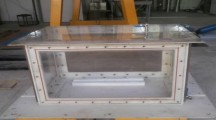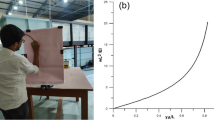Abstract
In order to study the properties of sound-speed dispersion in a sandy sediment, the sound speed was measured both at high frequency (90–170 kHz) and low frequency (0.5–3 kHz) in laboratory environments. At high frequency, a sampling measurement was conducted with boiled and uncooked sand samples collected from the bottom of a large water tank. The sound speed was directly obtained through transmission measurement using single source and single hydrophone. At low frequency, an in situ measurement was conducted in the water tank, where the sandy sediment had been homogeneously paved at the bottom for a long time. The sound speed was indirectly inverted according to the traveling time of signals received by three buried hydrophones in the sandy sediment and the geometry in experiment. The results show that the mean sound speed is approximate 1710–1713 m/s with a weak positive gradient in the sand sample after being boiled (as a method to eliminate bubbles as much as possible) at high frequency, which agrees well with the predictions of Biot theory, the effective density fluid model (EDFM) and Buckingham’s theory. However, the sound speed in the uncooked sandy sediment obviously decreases (about 80%) both at high frequency and low frequency due to plenty of bubbles in existence. And the sound-speed dispersion performs a weak negative gradient at high frequency. Finally, a water-unsaturated Biot model is presented for trying to explain the decrease of sound speed in the sandy sediment with plenty of bubbles.
Similar content being viewed by others
References
Berryman, J.G. and Thigpen, L., 1985. Effective constants for wave propagation through partially saturated porous media, Appl. Phys. Lett., 46(8), 722–724.
Biot, M.A., 1956. Theory of propagation of elastic waves in a fluidsaturated porous solid. I. Low-frequency range, J. Acoust. Soc. Am., 28(2), 168–178.
Biot, M.A., 1956. Theory of propagation of elastic waves in a fluidsaturated porous solid. II. Higher frequency range, J. Acoust. Soc. Am., 28(2), 179–191.
Buckingham, M.J., 1997. Theory of acoustic attenuation, dispersion, and pulse propagation in unconsolidated granular materials including marine sediments, J. Acoust. Soc. Am., 102(5), 2579–2596.
Buckingham, M.J., 1998. Theory of compressional and shear waves in fluidlike marine sediments, J. Acoust. Soc. Am., 103(1), 288–299.
Buckingham, M.J., 2000. Wave propagation, stress relaxation, and grain-to-grain shearing in saturated, unconsolidated marine sediments, J. Acoust. Soc. Am., 108(6), 2796–2815.
Buckingham, M.J., 2005. Compressional and shear wave properties of marine sediments: Comparisons between theory and data, J. Acoust. Soc. Am., 117(1), 137–152.
Donnell, M.O., Jaynes, E.T. And Miller, J.G., 1981. Kramers-Kronig relationship between ultrasonic attenuation and phase velocity, J. Acoust. Soc. Am., 69(3), 696–701.
Grosso, V.A. and Mader, C.W., 1972. Speed of sound in pure water, J. Acoust. Soc. Am., 52(5), 1442–1446.
Hamilton, E.L., 1980. Geoacoustic modeling of the sea floor, J. Acoust. Soc. Am., 68(5), 1313–1340.
Hefner, B.T. and Williams, K.L., 2006. Sound speed and attenuation measurements in unconsolidated glass-bead sediments saturated with viscous pore fluids, J. Acoust. Soc. Am., 120(5), 2538–2549.
Holland, C.W., Dettmer, J. and Dosso, S.E., 2005. A technique for measuring in-situ compressional wave speed dispersion in marine sediments, IEEE J. Ocean. Eng., 30(4), 748–763.
Horton, C.W., 1974. Dispersion relationships in sediments and sea water, J. Acoust. Soc. Am., 55(3), 547–549.
Horton, C.W., 1981. Comment on “Kramers-Kronig relationship between ultrasonic attenuation and phase velocity”, J. Acoust. Soc. Am., 70(4), 1182.
Li, H.X., Tao, C.H., Liu, F.L. and Zhou, J.P., 2015. Effect of gas bubble on acoustic characteristic of sediment: Taking sediment from East China Sea for example, Acta Phys. Sin., 64(10), 440–445. (in Chinese)
Schock, S.G., 2004. A method for estimating the physical and acoustic properties of the sea bed using chirp sonar data, IEEE J. Ocean. Eng., 29(4), 1200–1217.
Sessarego, J.P., Ivakin, A.N. and Ferrand, D., 2008. Frequency dependence of phase speed, group speed, and attenuation in water-saturated sand: Laboratory experiments, IEEE J. Ocean. Eng., 33(4), 359–366.
Tao, C.H., Li, H.X., Deng, X.M., Zhou, J.P., Fu, S.S., Wilkens, R.H., Gu, C.H. and He, Y.H., 2010. Study of a geo-acoustic model of gasbearing sediment and its application in sediment with low acoustic velocity, China Ocean Eng., 24(2), 381–390.
Thorsos, E.I., Williams, K.L., Chotiros, N.P. et al., 2001. An overview of SAX99: Acoustic measurements, IEEE J. Ocean. Eng., 26(1), 4–25.
Turgut, A. and Yamamoto, T., 2008. In situ measurements of velocity dispersion and attenuation in New Jersey Shelf sediments, J. Acoust. Soc. Am., 124(3), 122–127EL.
Williams, K.L., 2001. An effective density fluid model for acoustic propagation in sediments derived from Biot theory, J. Acoust. Soc. Am., 110(5), 2276–2281.
Williams, K.L., Jackson, D.R., Thorsos, E.I., Tang, D.J. and Schock, S.G., 2002. Comparison of sound speed and attenuation measured in a sandy sediment to predictions based on the Biot theory of porous media, IEEE J. Ocean. Eng., 27(3), 413–428.
Wingham, D.J., 1985. The dispersion of sound in sediment, J. Acoust. Soc. Am., 78(5), 1757–1760.
Zhou, J.X. and Zhang, X.Z., 2009. Low-frequency geoacoustic model for the effective properties of sandy seabottoms, J. Acoust. Soc. Am., 125(5), 2847–2866.
Zimmer, M.A., Bibee, L.D. and Richardson, M.D., 2010. Measurement of the frequency dependence of the sound speed and attenuation of seafloor sands from 1 to 400 kHz, IEEE J. Ocean. Eng., 35(3), 538–557.
Author information
Authors and Affiliations
Corresponding author
Additional information
Foundation item: This work was financially supported by the National Natural Science Foundation of China (Grant Nos. 41330965 and 41527809).
Rights and permissions
About this article
Cite this article
Yu, Sq., Liu, Bh., Yu, Kb. et al. Study on sound-speed dispersion in a sandy sediment at frequency ranges of 0.5–3 kHz and 90–170 kHz. China Ocean Eng 31, 103–113 (2017). https://doi.org/10.1007/s13344-017-0013-6
Received:
Revised:
Accepted:
Published:
Issue Date:
DOI: https://doi.org/10.1007/s13344-017-0013-6




